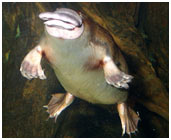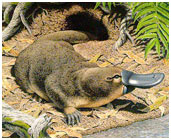Platypus is a semi-aquatic mammal, considered to be a fusion of a number of other species. With this article, get some interesting facts and amazing information on platypus.
Facts About Platypus
Platypus is the name given to a semi-aquatic mammal, found only in Eastern Australia, including Tasmania. It generally lives on the banks of river or freshwater lakes ar. It belongs to the monotremata order of the mammalian family. In other words, a platypus is amongst the five extant species of monotremes i.e. mammals that lay eggs instead of giving birth to young ones. It has very unique and unusual features. In fact, a platypus is considered to be an assortment of a number of species, namely the duck (bill and webbed feet), beaver (tail) and otter (body and fur). Platypuses hunt as well as mate underwater, but live on land. Platypuses were hunted for their furs but owing to a steep decline in their count in certain regions they are now protected, but as of now they don’t belong to the list of threatened, endangered or near threatened species. In the following lines, we have provided some interesting facts and amazing information on platypus.

Fast Facts
Binomial Name: Ornithorhynchus anatinus
Kingdom: Animalia
Phylum: Chordata
Class: Mammalia
Order: Monotremata
Family: Ornithorhynchidae
Genus: Ornithorhynchus
Species: O. anatinus
Length (males): 50 cm (20 in)
Length (females): 43 cm (17 in)
Weight: 700 g to 2.4 kg (1.54 to 5.3 lb)
Tail: 13 cm (5 in)
Age: Around 12 years
Natural Habitat: Eastern Australia, including Tasmania.
Diet: Carnivorous
Gestation Period: Around 28 days
Number of Eggs: 1-3
Interesting & Amazing Information On Platypus
- A platypus swims with its eyes, ears and nostrils shut. It propels forward with the help of its forefeet. The hind feet are used for the purpose of brakes and steering.
- When a platypus is on land, it turns back the webs on its front feet, in order to reveal broad nails that help it in walking.
- A platypus feeds on flies, small shrimps, worms, insect larvae and small aquatic creatures.
- Platypuses locate their prey with the help of electric signals from their bodies, with sensors on their bill. The bill of a Platypus is flexible and leathery.
- Platypuses mate in the water. However, the female lays the eggs on land, in a breeding burrow up to 20m long.
- The female platypus lays 1 to 3 eggs, which she incubates between her abdomen and tail.
- Since the female platypus does not have nipples, its young ones suck milk from patches on the abdomen.
- A platypus must consume at least one quarter of its body weight each day. This is why; it spends around 12 hrs. every day looking for food.
- Platypuses have been classified as "near threatened" by IUCN and are named on its Red List. The main reason for this is their susceptibility to water pollution.
- Platypus is one of the few venomous mammals. The male platypus can deliver poison, causing severe pain to humans, through a spur on its hind foot. The female can’t eject venom.
- Platypuses live near freshwater rivers or lakes and create burrows for shelter and protection.
- A platypus has a flat furry tail that stores fats for the winter season. The tail is also used as a rudder for steering.
- Platypuses have survived 17 years in captivity; however, the mortality is very high for Platypuses in their natural habitat.
- The oldest fossil of the modern platypus, which has been discovered was found to be around 100,000 year old belonging to the Quaternary period.
- The female platypus has two ovaries, however, the left ovary isn’t functional. Platypuses are also born with teeth.
- The Platypus is the only mammal to have extra bones in the shoulder girdle, including an interclavicle.
- Platypus feed on freshwater animals and fish such as shrimp, crayfish, mayflies, mussels, earthworms and dragonflies. They need to eat equal to around one-fourth of their body weight on a daily basis.
- Though Platypuses live on land, they mate underwater and use their tail to store fats.


See also
More from iloveindia.com
- Home Remedies | Ayurveda | Vastu | Yoga | Feng Shui | Tattoos | Fitness | Garden | Nutrition | Parenting | Bikes | Cars | Baby Care | Indian Weddings | Festivals | Party ideas | Horoscope 2015 | Pets | Finance | Figures of Speech | Hotels in India : Delhi | Hyderabad | Chennai | Mumbai | Kolkata | Bangalore | Ahmedabad | Jaipur
- Contact Us Careers Disclaimer Privacy Policy Advertise With Us Lifestyle Sitemap Copyright iloveindia.com. All Rights Reserved.




